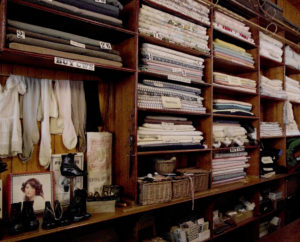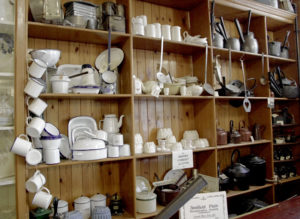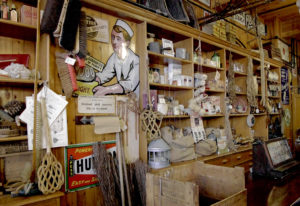The Co-operative movement began in the mid C19th selling quality goods at reasonable prices, breaking the monopoly of the truck system. Co-operative stores rapidly appeared across the country and soon any plkace of any size had its own co-op. Families became members of the organisation with their own divi number and profits were returned to members based on how much they had spent. The co-op also manufactured many of the goods on sale in its stores.
The Annfield Co-op building dominates the 1900s town. Dating from 1870, it had three departments, grocery, drapery and hardware.
Money was carried by the Lamson-Paragon ball cash carrying system. The cash was placed inside a hollow wooden ball which was carried on overhead tracks to the cash office where a record was made of the transaction and change and receipt was placed back in the ball and returned to the shop. This was later replaced by pneumatic tubes. These tubes survived in old fashioned shops until the 1950s.
Most Co-ops began as grocery stores and priority was given to CWS brands made specifically for them.
Many goods were sold loose and would be weighed and packeted for the customer, with the colour of the wrapping being colour coded. Sugar was always wrapped in a blue bag. Apparently if it rained and the packaging got wet, the blue dye wouldn’t stain the sugar, but would actually whitten it. (Remember those blue bags used for washing clothes?)
Butter arrived in barrels and was shaped into portions using wooden pats before being wrapped. Customers would be given the quantity required. Sides of bacon were hung from the ceiling and sliced to order. Pies, sausages and cheese were displayed on a marble slab to help keep them cool. Biscuits were sold lose by weight from metal tins. Fruit and vegetables werre displayed in boxes or baskets.
Housewives would shop daily and it was a social event and a chance to catch up with the latest gossip.
The Drapery store sold clothes, household linens, material as well as haberdashery.
Materials and household linens were kept on shelves to be displayed to the customer. Smaller items of clothing were stored in boxes which were opened and the articles taken out one by one for the customer to make their choice. Larger items of clothing were often hung from the ceiling. A chair was provided for favoured customers.
The hardware shop sold everything the housewife might need from pots and pans, china and pottery, to gas lights and cleaning equipment.
There are very knowledgeable costumed interpreters in the shops and it is worth making time to talk to them and ask questions.
This is one of a series of detailed “reviews”:https://www.silvertraveladvisor.com/travel-product/attraction/141741-beamish-open-air-museum I have written about Beamish.
A full account with all my pictures can be read “here.”:http://wasleys.org.uk/eleanor/presocialhistory/socialhistory/social/folkmuseums/beamish/index.html here.










